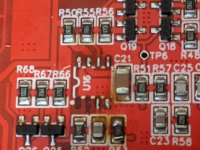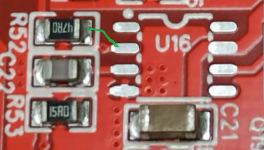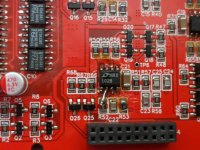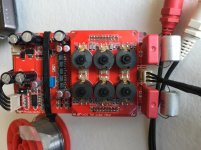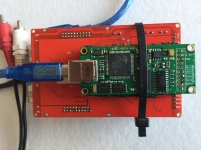I highly recommend for everyone to watch this DACs comparison:
ARES II vs D90 vs Bifrost 2 vs ADI-2 vs Gungnir vs Qutest [Mega DAC Roundup & Comparison] - YouTube, I have enjoyed it.
It is my understanding that Decadac with 7th order filter (the one I am going to build) is
closer in the sound signature to the Denafrips. It is the type sound I am after, right now - a bit less high energy details, softer sound and wider sound stage. Nevertheless I can't help myself but wondering - is it suitable for all types of music? Probably not. A question for Abraxalito - is it possible to make some interface for switching the filters? What is the difference in sound signature between the 3rd and the 7th? Are you planning to add some other filters in the future?
ARES II vs D90 vs Bifrost 2 vs ADI-2 vs Gungnir vs Qutest [Mega DAC Roundup & Comparison] - YouTube, I have enjoyed it.
It is my understanding that Decadac with 7th order filter (the one I am going to build) is
closer in the sound signature to the Denafrips. It is the type sound I am after, right now - a bit less high energy details, softer sound and wider sound stage. Nevertheless I can't help myself but wondering - is it suitable for all types of music? Probably not. A question for Abraxalito - is it possible to make some interface for switching the filters? What is the difference in sound signature between the 3rd and the 7th? Are you planning to add some other filters in the future?
Hi Youri - yes its possible to make some kind of interface for switching the filters but its quite a fiddle so I haven't tried to make one.
I'm of the view that the 7th order filter is the most neutral one, if you like a bit of flavouring then the 3rd order adds a slight 'edginess' to some vocals I've found and gives a bit less dynamic contrast. To my ears this kind of sound is more towards what I consider to be a 'mainstream' (i.e. S-D) DAC sound.
For the future I'm planning to experiment with digital filters. Then if we need to add some flavour we can do it much more conveniently in software. My intention is then to have a non-exchangeable analog filter and the DAC will use some degree of oversampling (likely just 2X but I'm not ruling out 4X).
I'm of the view that the 7th order filter is the most neutral one, if you like a bit of flavouring then the 3rd order adds a slight 'edginess' to some vocals I've found and gives a bit less dynamic contrast. To my ears this kind of sound is more towards what I consider to be a 'mainstream' (i.e. S-D) DAC sound.
For the future I'm planning to experiment with digital filters. Then if we need to add some flavour we can do it much more conveniently in software. My intention is then to have a non-exchangeable analog filter and the DAC will use some degree of oversampling (likely just 2X but I'm not ruling out 4X).
To get balanced output you'd need to yoke two Deca DACs together. The switch by the I2S input connector gives a digital inversion function. The first one of the DACs needs the switch in the default (non-inverting) position and gives the R+ and L+ outputs and the other needs the switch inverting to give R- and L-. Then take the balanced output between the two DACs (L+,L- and R+,R-).
I can't see that this approach would give an increment in SQ but I've not tried it myself to verify.
I can't see that this approach would give an increment in SQ but I've not tried it myself to verify.
I highly recommend for everyone to watch this DACs comparison:
ARES II vs D90 vs Bifrost 2 vs ADI-2 vs Gungnir vs Qutest [Mega DAC Roundup & Comparison] - YouTube, I have enjoyed it.
It is my understanding that Decadac with 7th order filter (the one I am going to build) is
closer in the sound signature to the Denafrips. It is the type sound I am after, right now - a bit less high energy details, softer sound and wider sound stage.
Hello Darksound! I'm still in the process of soldering the PhidecaDac, so I haven't been able to test it yet. When you comment that their sound with the 7th order filter is similar to the Denafrips Ares, is it an assumption or have you been able to compare them? I've always been very curious about Denafrips, that's why I'm asking you. Greetings!!
Hello,
my Decadac 7th order is working with a pair of K73 output caps.
I like very much, more than the previous version. I heard 3rd, 5th and 7th order filter.
7th is more natural/neutral, 5th is more life like.
Depends of the system, I prefer 7th order filter but with tube amps and full range speakers 5th order could be better.
Regards
Guglielmo
my Decadac 7th order is working with a pair of K73 output caps.
I like very much, more than the previous version. I heard 3rd, 5th and 7th order filter.
7th is more natural/neutral, 5th is more life like.
Depends of the system, I prefer 7th order filter but with tube amps and full range speakers 5th order could be better.
Regards
Guglielmo
Hello Darksound! I'm still in the process of soldering the PhidecaDac, so I haven't been able to test it yet. When you comment that their sound with the 7th order filter is similar to the Denafrips Ares, is it an assumption or have you been able to compare them? I've always been very curious about Denafrips, that's why I'm asking you. Greetings!!
Hi Cuhu!
It was educated guess
I highly recommend for everyone to watch this DACs comparison:
ARES II vs D90 vs Bifrost 2 vs ADI-2 vs Gungnir vs Qutest [Mega DAC Roundup & Comparison] - YouTube, I have enjoyed it.
It is my understanding that Decadac with 7th order filter (the one I am going to build) is
closer in the sound signature to the Denafrips. It is the type sound I am after, right now - a bit less high energy details, softer sound and wider sound stage.
I watched the first half of this video, he seems to say that the R2R DACs omit some 'detail' which he sometimes misses in comparison with the S-D ones. My view is that this 'detail' isn't present on the recording, its an artifact. The 'detailed' DACs are adding some extra HF emphasis which makes higher frequencies a bit brighter somehow. To give a video analogy, they're adding 'sharpening' making the sound seem more lively, energetic.
I would agree that the Dena DAC sound signature is the 'organic' one he gets from his Denafrips. What I don't know though is whether Dena DAC will be even more organic than that, given the Denafrips can operate in NOS mode without any filter, or perhaps just a 1st order one (I'm not knowledgeable about its circuitry). On Dena DAC reducing the filter order brings in a slight amount of 'sharpness' noticeable on vocals.
Hi Steven
I've added a green 'wire' to show the connection that's missing between pin2 U16 and R52 (47R) and needs adding with a short piece of wire. Pin1 has no connection anyway so the lack of pad isn't a problem.
I followed your instructions (see the attached image) and retested the voltages. I also verified the new connection by measuring about 47 ohms (as expected) from pin 2 of the LT1028 to the opposite terminal of the resistor. With reference to TP0:
TP1: 6.86V
TP2: 9.94
TP3: 5.00
TP4: 2.49
TP9: 12.40
TP10: 11.16
TP5: 10.02V
TP6: 2.41
TP7: 3.63
TP8: 11.48
Unfortunately, TP6 and TP8 are still far from the expected values... What do we do next?
Attachments
A couple of voltages to check - pin3 of U16 (relative to TP0) to see that the R53 resistor you removed did get its connection made properly again. Also check that the via joining R52 with R51 didn't get damaged. That track on the other side goes between R52 top (based on your most recent pic) and R51 bottom. Check that connection with an ohmmeter.
A couple of voltages to check - pin3 of U16 (relative to TP0) to see that the R53 resistor you removed did get its connection made properly again. Also check that the via joining R52 with R51 didn't get damaged. That track on the other side goes between R52 top (based on your most recent pic) and R51 bottom. Check that connection with an ohmmeter.
Pin 3 of U16: 185.4mV (Relative to TP0)
Top of R52 to bottom of R51: 0.00 ohms
Pin 3 of U16 should be at 6.8V so your measurement indicates R53 may be damaged (or a PCB track to it is damaged). Replace R53 with one of the new ones from Mouser.
At long last, she sings!!! Replaced the resistor, rechecked voltages, and all were well within tolerance.
First impressions, soundstage and imaging are much better than my old Cambridge Dacmagic Plus. Haven't done enough listening yet to say more.
Richard, my hat goes off to you. Thanks for all your help, I'll keep a close eye out for your future projects!
At long last, she sings!!! Replaced the resistor, rechecked voltages, and all were well within tolerance.
First impressions, soundstage and imaging are much better than my old Cambridge Dacmagic Plus. Haven't done enough listening yet to say more.
Richard, my hat goes off to you. Thanks for all your help, I'll keep a close eye out for your future projects!
Im really happy for you! I hope I will follow your steps soon. Richard has proven himself to be a crack at designing dacs and solving problems!
PhiDecoDac
https://www.diyaudio.com/forums/attachment.php?attachmentid=940276&stc=1&d=1617911139
Hi,
Firstly many thanks to Richard for making this Dac available for us simple soals/survivers!
In short time, Richard managed to get the dac parts to my adress in the Netherlands. Very well packed accompanied with several spares for critical parts With the help of the very clear soldering guide it was a rather easy job putting the parts on their spots. Just by using a fine tipped iron. Despite my being about eighty years old and having had only my first Covid vaccination! Hahaha!
Testround one and two showed all correct voltages and after putting everything together, the result was music in the first try!
Although this first setup is very basic : simple 500mA 15V wallwart, very simple C-Media audio Usb to I2S (12Us dollars!), standard delivered Wima 4,7uF MKF as output capacitor the Dac has a neutral caracter, very nice balanced.
I will let it go for a few weeks expecting some change in sound caracter.
Maybe than, I will try some other capacitors, or combinations of capacitors.
Another PSU, another Usb to I2s converter, maybe with nice clocks asf.
When I would do nothing at all, I must say the way it sounds now allready in this setup, is very satisfying!
BTW: I can compare (partly by memory) to DDDac1642, DDDac 1794 Nos Dac,1541Dac, Twisted pear Buff I and II,
https://www.diyaudio.com/forums/attachment.php?attachmentid=940276&stc=1&d=1617911139
Hi,
Firstly many thanks to Richard for making this Dac available for us simple soals/survivers!
In short time, Richard managed to get the dac parts to my adress in the Netherlands. Very well packed accompanied with several spares for critical parts With the help of the very clear soldering guide it was a rather easy job putting the parts on their spots. Just by using a fine tipped iron. Despite my being about eighty years old and having had only my first Covid vaccination! Hahaha!
Testround one and two showed all correct voltages and after putting everything together, the result was music in the first try!
Although this first setup is very basic : simple 500mA 15V wallwart, very simple C-Media audio Usb to I2S (12Us dollars!), standard delivered Wima 4,7uF MKF as output capacitor the Dac has a neutral caracter, very nice balanced.
I will let it go for a few weeks expecting some change in sound caracter.
Maybe than, I will try some other capacitors, or combinations of capacitors.
Another PSU, another Usb to I2s converter, maybe with nice clocks asf.
When I would do nothing at all, I must say the way it sounds now allready in this setup, is very satisfying!
BTW: I can compare (partly by memory) to DDDac1642, DDDac 1794 Nos Dac,1541Dac, Twisted pear Buff I and II,
Attachments
- Home
- Vendor's Bazaar
- PhiDAC hex kits with pre-built filters
